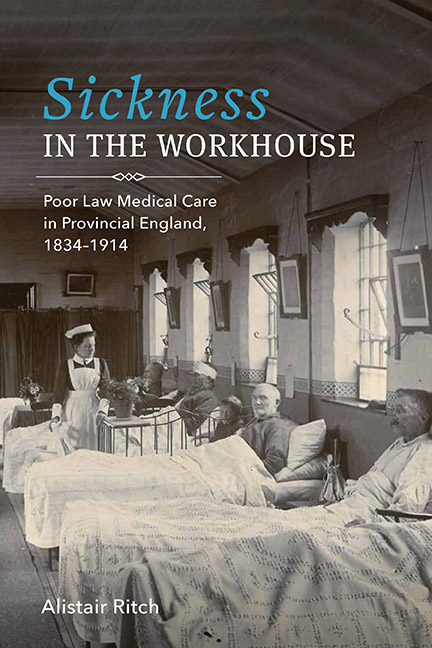Book contents
- Frontmatter
- Dedication
- Contents
- List of Tables
- Acknowledgments
- Introduction: Pauperism and Sickness
- 1 From Acute Illness to Chronic Disability
- 2 Segregating Fever Patients
- 3 Controlling Disorderly Behavior
- 4 Day-to-day Doctoring
- 5 Medical Therapies
- 6 Poor Law Nursing
- 7 “Every Care and Kindness”: The Standard of Workhouse Medicine
- Appendix A Prevalence of Selected Infectious Diseases in Birmingham Workhouse on the Last Day of the First Week of Each Quarter for the Years 1877–80 and 1894–1911
- Appendix B Medical Relief in Birmingham Workhouse for Selected Weeks, 1851–56
- Appendix C List of Drugs Kept in the Wards of Birmingham Infirmary in 1896
- Appendix D Pauperism Rates and Institutionalization Rates for Birmingham Parish, Wolverhampton Union, and England and Wales, 1840–1911
- Notes
- Bibliography
- Index
2 - Segregating Fever Patients
Published online by Cambridge University Press: 21 March 2020
- Frontmatter
- Dedication
- Contents
- List of Tables
- Acknowledgments
- Introduction: Pauperism and Sickness
- 1 From Acute Illness to Chronic Disability
- 2 Segregating Fever Patients
- 3 Controlling Disorderly Behavior
- 4 Day-to-day Doctoring
- 5 Medical Therapies
- 6 Poor Law Nursing
- 7 “Every Care and Kindness”: The Standard of Workhouse Medicine
- Appendix A Prevalence of Selected Infectious Diseases in Birmingham Workhouse on the Last Day of the First Week of Each Quarter for the Years 1877–80 and 1894–1911
- Appendix B Medical Relief in Birmingham Workhouse for Selected Weeks, 1851–56
- Appendix C List of Drugs Kept in the Wards of Birmingham Infirmary in 1896
- Appendix D Pauperism Rates and Institutionalization Rates for Birmingham Parish, Wolverhampton Union, and England and Wales, 1840–1911
- Notes
- Bibliography
- Index
Summary
Nineteenth-century Britain was characterized by epidemics and the widespread prevalence of infectious diseases. They were the most common causes of morbidity and mortality and with the exclusion of bronchitis and pneumonia accounted for 33 percent of deaths in the years 1848‒72 in England and Wales. When these respiratory diseases are included, infection was the cause of 48 percent of deaths nationally in 1851‒60. Communicable diseases were more prevalent in areas wherever people were crowded together and rapid urban growth occurred in the early nineteenth century, and its associated problems of sewerage and water supply multiplied the risk of infection. Thus, urban environments became more unhealthy and allowed diseases to become endemic. According to Anne Hardy, there grew up within these areas “fever nests,” from where the Victorians feared that epidemics could escape and spread to the rest of the population. For example, Whitechapel was considered the “nucleus of the metropolitan fever field,” while Southwark held the same status within the cholera field in London.
The mortality rate from infectious diseases declined markedly in the second half of the nineteenth century, both in absolute terms and in relative importance among all causes of disease. In 1901‒10, they accounted for only 19 percent of all deaths. This mortality decline was accompanied by an epidemiological transition, with degenerative diseases such as cardiovascular disease and cancer replacing pandemics of infection as primary causes of morbidity and mortality. This shift in disease patterns, with a progressive decline in infectious diseases, began in the mid-eighteenth century, but a more marked fall in overall mortality rate in England and Wales took place from the middle of the following century. The reasons for the mortality decline have long been a contentious issue among historians and epidemiologists. Abdel Omran, who first proposed the theory of “epidemiologic” transition, ascribed the decline of infection in western European societies to socioeconomic factors, augmented by the sanitary revolution in the late nineteenth century. The work of Thomas McKeown has been influential in stressing the primary reason as the improving nutritional status of the population. However, Simon Szreter argues that preventive public health provision and services were more important in explaining the mortality decline. Hardy's view is that no one factor was of overriding importance in reducing death rates, but the measures taken by the preventive authorities made a fundamental contribution.
- Type
- Chapter
- Information
- Sickness in the WorkhousePoor Law Medical Care in Provincial England, 1834–1914, pp. 66 - 93Publisher: Boydell & BrewerPrint publication year: 2019



